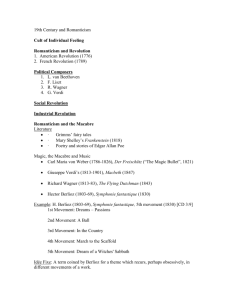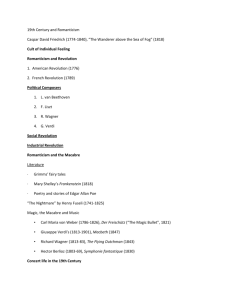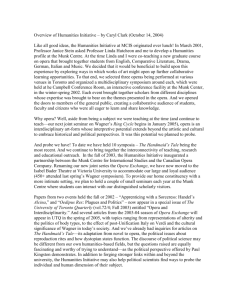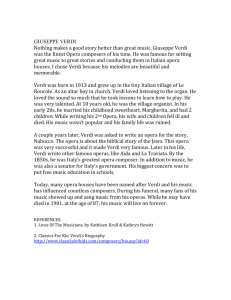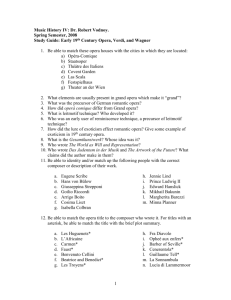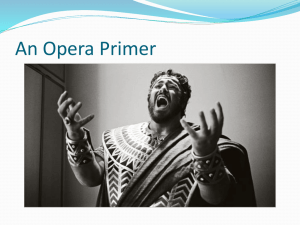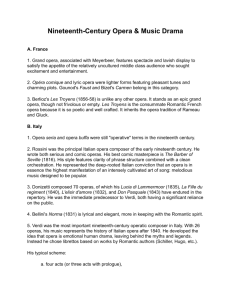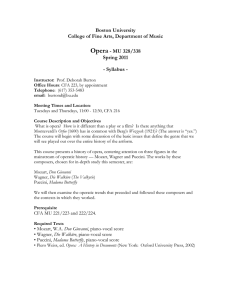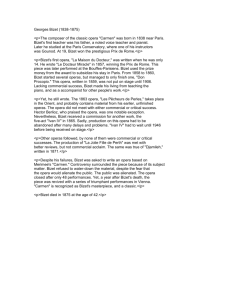20 Romantic Unit 20
advertisement
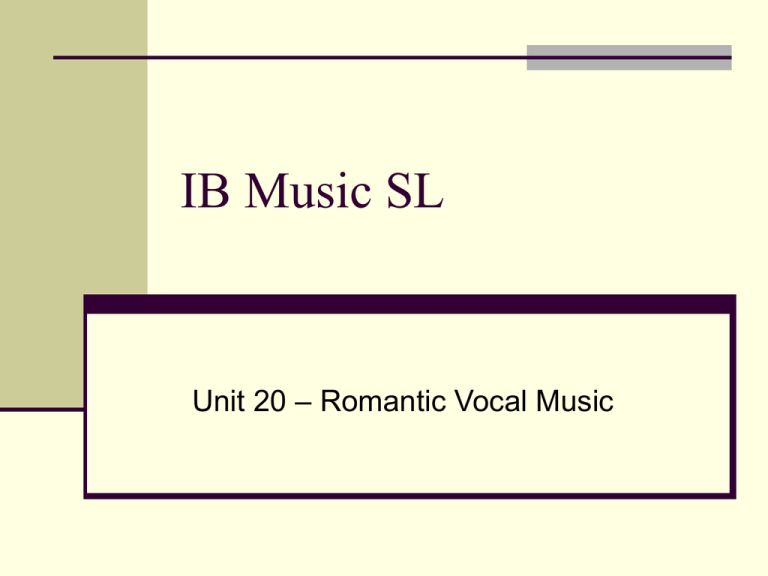
IB Music SL Unit 20 – Romantic Vocal Music Romantic Choral Music Increased popularity Choral music societies as artistic outlet Part songs, the oratorio, the Mass, and the Requiem Mass Repetition helps lead to understanding Brahms: A German Requiem Protestant tradition (console the living) Old Testament: Psalms, Proverbs, Isaiah, Ecclesiastes New Testament: Paul, Matthew, Peter, John, Revelation Written after deaths of Robert Schumann and Brahms’s mother Soloists, four-part chorus, and orchestra 7 movements, arch form Connections between movements: 1 and 7 2 and 6 3 and 5 Brahms: A German Requiem Fourth movement chorus, How lovely is thy dwelling place Centerpiece of work Psalm 84 Form: A-B-A′-C-A′ Fanny Mendelssohn Hensel and the Romantic Part Song Fanny Mendelssohn Hensel (1805-1847) Older sister of Felix, raised in Berlin Trained on the piano and in composition Encouraged (as a female) not to pursue music as a career Recognized as a gifted artist Participated in salon concerts at parent's home After her mother's death Fanny took over the concerts Died suddenly of a apoplectic stroke in 1847 Fanny Mendelssohn's Music Output dominated by Lieder, choral part songs and piano music Some large-scale works Keyboard music reflects her interest in Bach's contrapuntal procedures In her Lieder she favored the poetry of Goethe Fanny Mendelssohn Hensel: Under the Greenwood Tree Four-voice part song A cappella Text drawn from Shakespeare's As You Like It Strophic, with two verses Chorus "Come hither" follows each verse Changing textures provide interest Romantic Opera Basic emotions with an elemental force Suspension of disbelief Superstar performers, extravagant scenery The Development of National Styles France Grand opera Opéra comique Germany Singspiel Music drama Italy Opera seria Opera buffa Bel canto singing style Exoticism in Opera Verdi’s Aida Saint-Saëns’s Samson and Delilah Richard Strauss’s Salome Music suggests faraway locale Georges Bizet (1838–1875) French lyric opera composer Prix de Rome Carmen & Roma (Gypsy) culture in Spain Based on Merimée’s story Realism in opera Bizet: Carmen excerpt Love, hate, desire Disintegration of a personality Tempestuous Carmen is central figure Music evokes colors of Spain Realism, sensuality, and a tragic end Cuban habanera Women in Opera Visibility for women composers: Louise Bertin La Esmerelda And singers Jenny Lind (1820–1887) Maria Malibran (1808–1836) Pauline Viardot (1821–1910) Verdi and Italian Opera Giuseppe Verdi (1813–1901) Italian composer Studies in Milan Austrian Hapsburg rule Patriotic, nationalistic works 28 operas Composed successfully until age 80 Died at 87 National hero Verdi’s Music Romantic drama and passion Melody above all Three compositional periods Early period: Middle period (French grand opera): Macbeth, Rigoletto, Il trovatore, La traviata A Masked Ball, The Force of Destiny, Don Carlos Final period: Aida, Otello, Falstaff Verdi: Rigoletto Based on Victor Hugo’s The King is Amused Libretto by Francesco Piave Three acts Renaissance Mantua Themes of seduction and deceit, with a tragic end Popular moments from Act III: Tenor aria, “La donna è mobile” Strophic Quartet, “Un di” 4 characters/emotions Wagner and the Music Drama Richard Wagner (1813–1883) German composer, early career in Dresden Grand operas, nationalistic operas Exile in Switzerland after 1849 Art and Revolution, The Art Work of the Future, and Opera and Drama Music drama The Ring of the Nibelung Ludwig II summoned him back to Germany Festival Theater at Bayreuth Married Cosima Liszt Last work: Parsifal Died at age 70 Wagner’s Music Music dramas “Endless melody” Total artwork (Gesamtkunstwerk) Orchestra as unifying element Leitmotifs Chromatic dissonance Wagner: Die Walküre excerpt The Ring of the Nibelung Gold in the Rhine River Rhine Maidens Norse sagas, medieval German epic poem, the Nibelungenlied Cycle: Das Rheingold, Die Walküre, Siegfried, Götterdämmerung Wagner: Die Walküre Act III (Finale) of Die Walküre Leitmotifs: slumber, magic sleep, magic fire, and Siegfried Puccini and Late Romantic Opera Post-Romantic Italian composers verismo Pietro Mascagni, Ruggero Leoncavallo and Giacomo Puccini Giacomo Puccini (1858–1924) Italian composer Early operatic successes: Manon Lescaut, La bohème, Tosca, Madame Butterfly Last work Turandot left unfinished Died in 1924 of a heart attack Puccini: Madame Butterfly 1 2 Verismo and exoticism Inspired by performance of a play Disastrous premiere Revised version Central tragic-heroic character: geisha CioCio-San Act II, Cio-Cio-San’s aria “Un bel di” describes desire for her lover’s return Tchaikovsky and the Ballet Ballet—Past and Present Part of larger work: intermedio, masque, ballet de cour Independent art form in 18th century (France and Russia) 19th-century Russian ballet (czar’s court) Marius Petipa (St. Petersburg) Pas de deux Serge Diaghilev (1872–1929) Ballets Russes Vaslav Nijinksy and Tamara Karsavina Picasso and Braque Igor Stravinsky Igor Stravinsky Peter Ilyich Tchaikovsky (1840–1893) Russian composer End-of-the-century pessimism Sexual identity Antonina Milyukova Nadezhda von Meck Correspondence Carnegie Hall in New York (1891) Died suddenly at age 53 Tchaikovsky: The Nutcracker Swan Lake, Sleeping Beauty, The Nutcracker The Nutcracker by E. T. A. Hoffmann Christmas tale: Clara and her gift nutcracker March, Act I Dance of the Sugar Plum Fairy Celesta “Exotic” dances: Arab, Chinese, Trepak
